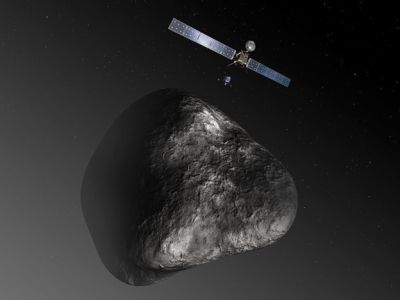01 April 2014

This is an artist concept, showing the Rosetta spacecraft and the probe Philae, at their ultimate target, Comet 67P.
Credit: ESA–C. Carreau/ATG medialab
The comet-bound Rosetta spacecraft, of the European Space Agency (ESA), has relayed the first images of its ultimate target, Comet Churyumov-Gerasimenko, also known as 67P. Rosetta is scheduled to arrive at Comet 67P, in August 2014. It will orbit 67P, for 17 months, to conduct the most detailed study of a comet ever. It has been in a long space hibernation interval, which lasted 957 days, ending on 20 January 2014, when the project’s scientists reactivated its onboard computers.
Comets are small icy objects orbiting the Sun, measuring typically a few kilometers across. They are believed to be primitive cosmic objects, whose chemical makeup has remained almost unchanged, unlike the planets, which have been continuously evolving, since the birth of the solar system. Therefore, scientists hope that Rosetta will unlock the secrets of comets, and yield new insights into the formation of the planets and the early solar system.
Comet 67P was discovered in 1969, by Klim Ivanovych Churyumov, in images taken by Svetlana Ivanova Gerasimenko. It orbits the Sun every 6.45 years, and its distance from the Sun varies between about 180 million km and 850 million km.
Rosetta’s first two images of 67P were taken by OSIRIS, a sophisticated instrument aboard Rosetta, on March 20 and 21, when the spacecraft was at a distance of about five million kilometers from 67P. This preliminary imaging of 67P is part of a procedure, lasting six weeks, aiming to prepare Rosetta’s science instruments, for studying 67P.
Rosetta, named after the Rosetta Stone, the ancient Egyptian stela, which allowed to decipher the Egyptian hieroglyphs, will also send a small probe, named Philae, after an Egyptian Nile island, to land on the surface of 67P, in November 2014. Philae will study and sample 67P’s surface. This will also be the first landing on a comet. (Interestingly, an ancient Egyptian text, found on the Island of Philae, helped to interpret the Rosetta Stone.)
Rosetta was built and launched by ESA, and carries onboard three NASA instruments. It blasted into space, on 2 March 2004, on a powerful Ariane 5 rocket, from the Guiana Space Center in French Guiana.
References
NASA
ESA
Wikipedia
Aymen Mohamed Ibrahem
Senior Astronomy Specialist